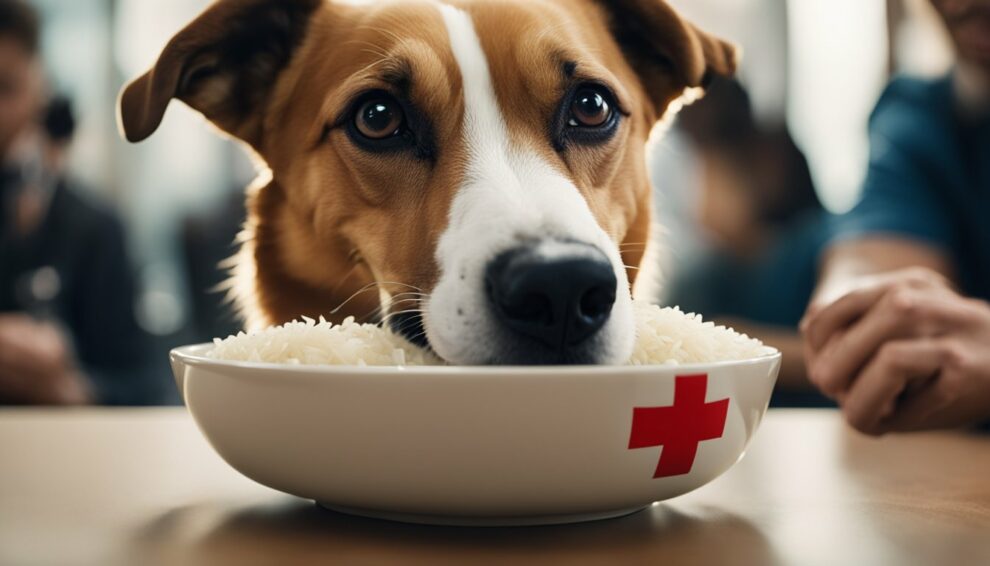When it comes to feeding our dogs, we always want to make sure we’re giving them the best.
Often, we hear that rice is a good food option, especially when our furry friends are dealing with stomach issues.
Rice is known for being a gentle carb that’s easy on a dog’s digestive system, and it’s a common ingredient in many dog foods.
But, should we be feeding our dogs rice as a part of their regular diet?

We need to consider the nutritional needs of our dogs, which can be vastly different from our own.
While rice is not harmful in itself and can indeed be a useful ingredient during bouts of gastrointestinal upset, it may not be the best choice for our dog’s everyday meals.
Continuous consumption of rice by dogs, especially in large quantities, may lead to unanticipated health issues.
Our dogs rely on us to make informed choices about their diet, and with the abundance of information available, it’s essential that we parse through what’s best for our dog’s long-term wellbeing.
While rice can serve as a temporary dietary aid, there are several reasons why it shouldn’t become a staple of our dog’s diet.
Let’s explore the potential impacts that feeding rice to dogs can have, and consider healthier alternatives to ensure our pets stay happy and healthy.
The Nutritional Impact of Rice on Dogs

Rice is a common staple in many households, and it’s often a go-to option when our dogs need a bland diet.
However, it’s essential to understand its nutritional role in their diet comprehensively.
Understanding Carbohydrates in a Dog’s Diet
Rice is a carbohydrate, providing energy to our dogs.
However, dogs have no nutritional requirement for carbohydrates in their diet, as they can get their energy from proteins and fats.
While carbs can be an energy source, they should not displace essential nutrients from proteins and fats.
In high amounts, carbohydrates can lead to unnecessary weight gain and potentially disrupt the nutritional balance in our dog’s diet.
Differences Between White and Brown Rice
When we consider feeding rice to our dogs, we must appreciate that white rice and brown rice have distinct nutritional profiles.
White rice is a refined grain with the bran and germ removed, which also strips away many vitamins and minerals.
In contrast, brown rice retains the bran and germ, making it rich in nutrients and fiber but also harder to digest.
For dogs with sensitive stomachs, brown rice might not be the best choice despite its nutritional advantages.
| White Rice | Brown Rice | |
|---|---|---|
| Fiber | Lower | Higher |
| Nutrition | Fewer vitamins & minerals | More vitamins & minerals |
| Digestibility | Easier to digest | Less digestible |
Protein, Fat, and Fiber: The Balance with Rice
Rice on its own is low in protein and fat — essential components for our dog’s diet.
While it can be part of a balanced meal, we must ensure that dogs receive these essential nutrients from other sources.
Too much rice can also lead to a dietary imbalance, with a high carbohydrate to protein ratio, potentially affecting muscle maintenance and overall health.
The fiber in rice, particularly brown rice, can be beneficial for our dog’s digestion, but it should be fed in moderation to avoid nutritional imbalances.
Potential Health Concerns When Feeding Your Dog Rice

Before we explore the specific health concerns, it’s important for us to recognize that while rice can be a quick energy source, it may not be suitable for all dogs, especially when it comes to their long-term health.
Concerns range from blood sugar spikes due to the high glycemic index to the potential for allergic reactions and gastrointestinal upset.
Let’s take a closer look at the risks involved.
Rice and Canine Diabetes Risk
Feeding rice to our furry friends may increase their risk of diabetes, particularly in breeds that are prone to the condition.
The problem is the quick conversion of rice into glucose, which can cause blood sugar levels to rise rapidly.
Dogs that eat a lot of high-glycemic foods may become overweight or obese, and these conditions further compound the risk for diabetes.
It’s essential for us to carefully monitor their diet and consult a veterinarian if we’re considering including rice in a dog’s meal plan, especially for those with existing health issues.
Understanding the Glycemic Index of Rice
The glycemic index (GI) is a measure that ranks foods on how they affect our blood sugar.
Rice, particularly white rice, has a high glycemic index, which means it can cause a sharp increase in our dog’s blood sugar levels.
If we frequently opt for rice in their diet, we’re risking repeated blood sugar spikes which are not only harmful for diabetic dogs but can also predispose healthy dogs to the condition.
Choosing complex carbohydrates with a lower GI may be a more suitable option to provide a steadier energy release.
Gastrointestinal Issues and Allergic Reactions
While rice is often recommended for dogs with a mild upset stomach or diarrhea, it’s not ideal for all canines.
Some dogs may develop allergic reactions to rice, manifesting as itchy skin, inflamed paws, dry skin, or even hair loss.
We should watch out for these signs and consider a hypoallergenic diet if our dogs show symptoms of food sensitivities.
Additionally, a diet high in rice may not provide enough of the essential nutrients dogs need, which could contribute to gastrointestinal distress and vomiting.
As responsible pet owners, we need to ensure that our dogs’ diets are balanced and beneficial to their overall health.
Rice in Commercial Dog Food Versus Home-Cooked Meals

When we consider incorporating rice into our dog’s diet, it’s vital to distinguish the rice content in commercial dog food from the rice we might prepare at home.
Rice is often used in dog food brands for its carbohydrate content, but the way it’s prepared and served can make a significant difference.
Comparing Rice Content in Dog Food Brands
Commercial dog food often includes rice as a source of carbohydrates.
It fulfills the energy needs of dogs and is generally considered safe as it must meet the minimal requirements set by authorities like the Association of American Feed Control Officials (AAFCO).
However, as pet owners, we need to scrutinize the labels and select dog food brands that offer a balanced diet, ensuring that rice does not overshadow the essential proteins and fats that our dogs need.
| Brand | Rice Content | Protein Source | Additional Notes |
|---|---|---|---|
| Brand A | High | Chicken | Includes rice as a main ingredient |
| Brand B | Moderate | Beef | Uses brown rice for added fiber |
| Brand C | Low | Lamb | Rice is a minor ingredient; grain-free options available |
Preparing Rice for Dogs: Do’s and Don’ts
When we decide to prepare home-cooked meals, including rice, it’s crucial to know the do’s and don’ts.
Cooked rice should be plain, as onions, garlic, and certain spices can be toxic to dogs.
If you’re introducing new food like rice to your dog’s diet, it’s best done gradually to monitor for any adverse reactions.
Always prioritize unseasoned, well-cooked rice and consult your veterinarian about the proportion of rice to include in your dog’s meal to maintain a balanced diet.
- Do: Serve plain, well-cooked rice, and ensure it’s cooled down before offering it to your dog.
- Don’t: Add seasonings, salt, or oil which can be harmful to your dog’s health.
- Moderation is key – rice should complement the meal, not be the main focus.
Using this guidance, we can make informed choices about including rice in our furry friends’ diets, whether it’s through commercial dog food or home-cooked meals.
Alternatives to Rice in a Dog’s Diet

When we look at our furry friends’ diets, it’s important to understand that they need a variety of nutrients to stay healthy.
If you’re considering alternatives to rice, there are plenty of nutritious options that can provide a balanced diet for your dog.
Let’s explore some healthy grains and vegetables, as well as meat and protein alternatives, that can benefit your dog’s meal plan.
Healthy Grains and Vegetables for Dogs
Our dogs can enjoy a range of grains that offer substantial nutritional value.
For those pups who might be sensitive to rice or if you’re simply looking for variety, here are some excellent grain choices:
- Oats: A great source of fiber, which aids in digestion.
- Quinoa: Rich in protein and all nine essential amino acids.
- Barley: Contains beta-glucans, known for their antioxidant and immune-boosting properties.
- Rye: Low in fat and can help support a healthy weight.
Incorporating vegetables into your dog’s diet can also provide essential vitamins and antioxidants.
Some vegetable options include:
- Sweet potatoes: A vitamin-rich alternative that’s also a good carb source.
- Pumpkin: High in fiber and antioxidants.
- Peas: Offer vitamins A, B, and K, as well as iron and zinc.
Meat and Protein Alternatives
Protein is an essential part of our dog’s diet and crucial for their overall health.
Instead of rice, you can supplement their meals with various meats and other protein-rich foods:
- Cooked lean meats: Chicken, turkey, and beef, without any added spices or sauces.
- Fish: Occasionally providing fish can add omega-3 fatty acids to their diet, which is good for their coat and skin.
- Eggs: Easily digestible and high in protein.
Remember to introduce new foods gradually to avoid upsetting your dog’s stomach and to ensure they don’t have any allergies or intolerances.
By varying the grains, vegetables, and protein sources, we can offer our dogs a balanced diet that meets their nutritional needs and keeps them thriving.
Consulting with Veterinarians on Diet Changes
When we, as pet owners, consider changing our dog’s diet, the safest approach is to consult with a veterinarian.
These healthcare professionals have the training to guide us through the nutritional needs and safety considerations for our furry friends.
Why Consult a Veterinarian?
- Expert Guidance: Veterinarians can offer individualized advice, ensuring our dogs get the nutrition they need.
- Health Assessment: They evaluate our dog’s overall health and recommend diets that support wellness and manage any medical conditions.
Before Making Changes
- Assess Current Diet: Outline your dog’s current feeding routine and any reactions to their present diet.
- Identify Goals: Clearly explain why you want to make a change.
Is it for health benefits or due to observed issues?
During the Consultation
- Discuss your dog’s health history and any existing conditions.
- Be transparent about your dog’s activity level and current food preferences.
- Bring up any concerns you have about ingredients like rice that you may want to include or remove.
After the Visit
- Follow their guidance and introduce any new foods in moderation.
- Monitor your dog’s response to the dietary shift, noting both positive changes and potential adverse reactions.
By involving veterinarians in the decision-making process, we can better understand the balance between health benefits and risks associated with diet changes.
Their expertise is invaluable in keeping our dogs on the path to a happy, healthy life.















